
math nots for class 12 download pdf application of integrals chapter 8: , application of integrals 12 notes, class 12 maths notes, application of integrals class 12, application of integrals class 12 notes, class 12 application of integrals, note maths, maths notes, application of integrals, class 12 cmaths chapter 8 notes, 12th standard maths notes, 12th std maths notes, class 12 maths notes chapter 8, application of integrals chapter class 12 notes
Let f(x) be a function defined on the interval [a, b] and F(x) be its anti-derivative. Then,
![]()
The above is called the second fundamental theorem of calculus.
![]() is defined as the definite integral of f(x) from x = a to x = b. The numbers and b are
called limits of integration. We write
is defined as the definite integral of f(x) from x = a to x = b. The numbers and b are
called limits of integration. We write
![]()
Consider a definite integral of the following form
![]()
Step 1 Substitute g(x) = t
⇒ g ‘(x) dx = dt
Step 2 Find the limits of integration in new system of variable i.e.. the lower limit is g(a) and
the upper limit is g(b) and the g(b) integral is now![]()
Step 3 Evaluate the integral, so obtained by usual method.
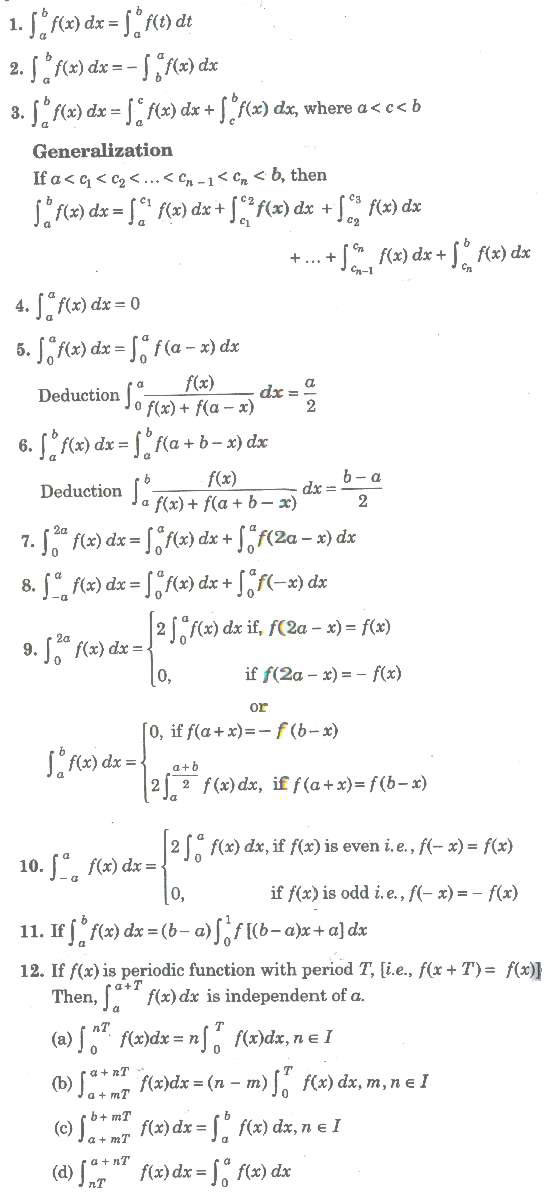
(a) If Φ(x) and ψ(x) are defined on [a, b] and differentiable for every x and f(t) is continuous, then

(b) If Φ(x) and ψ(x) are defined on [a, b] and differentiable for every x and f(t) is continuous, then

14. If f(x) ≥ 0 on the interval [a, b], then![]()
15. If (x) ≤ Φ(x) for x ∈ [a, b], then ![]()
16. If at every point x of an interval [a, b] the inequalities g(x) ≤ f(x) ≤ h(x) are fulfilled, then

18. If m is the least value and M is the greatest value of the function f(x) on the interval [a, bl. (estimation of an integral), then
![]()
19. If f is continuous on [a, b], then there exists a number c in [a, b] at which

is called the mean value of the function f(x) on the interval [a, b].
20. If f22 (x) and g2 (x) are integrable on [a, b], then
![]()
21. Let a function f(x, α) be continuous for a ≤ x ≤ b and c ≤ α ≤ d.
Then, for any α ∈ [c, d], if
![]()
22. If f(t) is an odd function, then![]() is an even function.
is an even function.
23. If f(t) is an even function, then![]() is an odd function.
is an odd function.
24. If f(t) is an even function, then for non-zero a,![]() is not necessarily an odd function.
It will be an odd function, if
is not necessarily an odd function.
It will be an odd function, if
![]()
25. If f(x) is continuous on [a, α], then![]() is called an improper integral and is defined
as
is called an improper integral and is defined
as![]()

27. Geometrically, for f(x) > 0, the improper integral![]() gives area of the figure
bounded by the curve y = f(x), the axis and the straight line x = a.
gives area of the figure
bounded by the curve y = f(x), the axis and the straight line x = a.
Let f(x) be a continuous function defined on [a, b], then a function φ(x) defined
by![]() is called the integral function of the function f.
is called the integral function of the function f.
1. The integral function of an integrable function is continuous.
2. If φ(x) is the integral function of continuous function, then φ(x) is derivable and of φ ‘ =
f(x) for all x ∈ [a, b].
If n is a positive rational number, then the improper integral![]() is defined as a
gamma function and it is denoted by Γn
is defined as a
gamma function and it is denoted by Γn
![]()
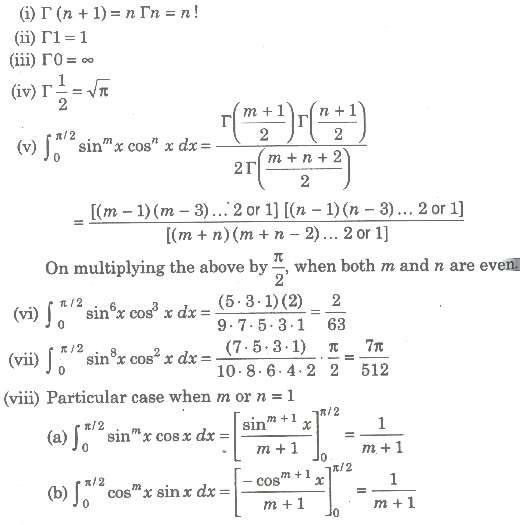

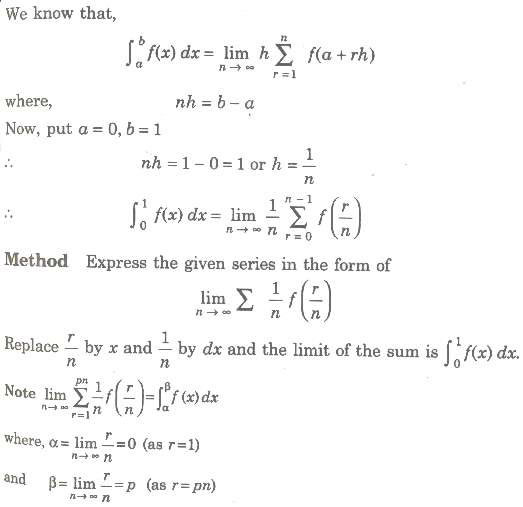
The method to evaluate the integral, as limit of the sum of an infinite series is known as integration by first principle.

The space occupied by the curve along with the axis, under the given condition is called area of bounded region.
(i) The area bounded by the curve y = F(x) above the X-axis and between the lines x = a, x = b
is given by ![]()
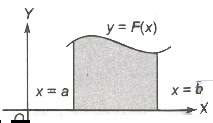
(ii) If the curve between the lines x = a, x = b lies below the X-axis, then the required area is given by
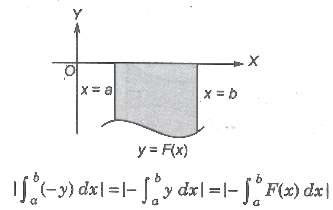
(iii) The area bounded by the curve x = F(y) right to the Y-axis and the lines y = c, y = d is given by
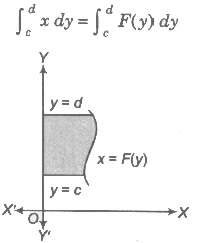
(iv) If the curve between the lines y = c, y = d left to the Y-axis, then the area is given by
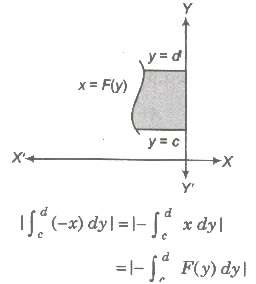
(v) Area bounded by two curves y = F (x) and y = G (x) between x = a and x = b is given by
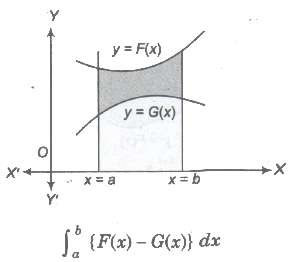
(vi) Area bounded by two curves x = f(y) and x = g(y) between y=c and y=d is given
by![]()
(vii) If F (x) ≥. G (x) in [a, c] and F (x) ≤ G (x) in [c,d], where a < c < b, then area of the region bounded by the curves is given as
![]()
Let f(θ) be a continuous function, θ ∈ (a, α), then the are t bounded by the curve r = f(θ) and <β) is

Let x = φ(t) and y = ψ(t) be two parametric curves, then area bounded by the curve, X-axis and ordinates x = φ(t1), x = ψ(t2) is
![]()
If We revolve any plane curve along any line, then solid so generated is called solid of revolution.
1. The volume of the solid generated by revolution of the area bounded by the curve y =
f(x), the axis of x and the ordinates![]() it being given that f(x) is a continuous a
function in the interval (a, b).
it being given that f(x) is a continuous a
function in the interval (a, b).
2. The volume of the solid generated by revolution of the area bounded by the curve x =
g(y), the axis of y and two abscissas y = c and y = d is![]() it being given that
g(y) is a continuous function in the interval (c, d).
it being given that
g(y) is a continuous function in the interval (c, d).
(i) The surface of the solid generated by revolution of the area bounded by the curve y = f(x),
the axis of x and the ordinates is a continuous function in the interval (a, b).
is a continuous function in the interval (a, b).
(ii) The surface of the solid generated by revolution of the area bounded by the curve x = f (y),
the axis of y and y = c, y = d is![]() continuous function in the interval
(c, d).
continuous function in the interval
(c, d).
1. If powers of y in a equation of curve are all even, then curve is symmetrical about Xaxis.
2. If powers of x in a equation of curve are all even, then curve is symmetrical about Yaxis.
3. When x is replaced by -x and y is replaced by -y, then curve is symmetrical in opposite
quadrant.
4. If x and y are interchanged and equation of curve remains unchanged curve is
symmetrical about line y = x.
1. If point (0, 0) satisfies the equation, then curve passes through origin.
2. If curve passes through origin, then equate low st degree term to zero and get equation of
tangent. If there are two tangents, then origin is a double point.
1. Put y = 0 and get intersection with X-axis, put x = 0 and get intersection with Y-axis.
2. Now, find equation of tangent at this point i. e. , shift origin to the point of intersection
and equate the lowest degree term to zero.
3. Find regions where curve does not exists. i. e., curve will not exit for those values of
variable when makes the other imaginary or not defined.
1. Equate coefficient of highest power of x and get asymptote parallel to X-axis.
2. Similarly equate coefficient of highest power of y and get asymptote parallel to Y-axis.
Find points at which (dy/dx) vanishes or becomes infinite. It gives us the points where tngent is parallel or perpendicular to the X-axis.
![]() and solve the resulting equation.If some point of inflexion is there,
then locate it exactly.
and solve the resulting equation.If some point of inflexion is there,
then locate it exactly.
Taking in consideration of all above information, we draw an approximate shape of the curve
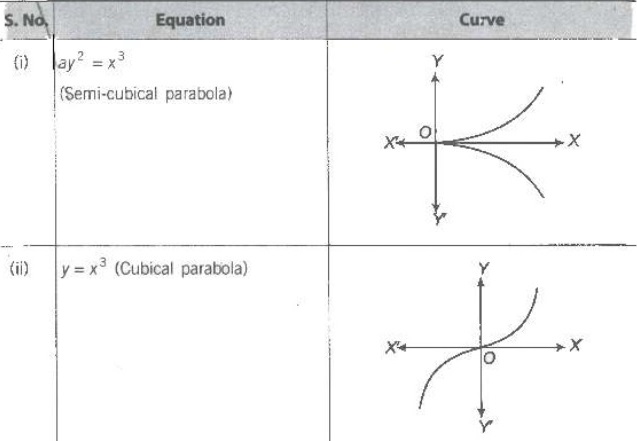
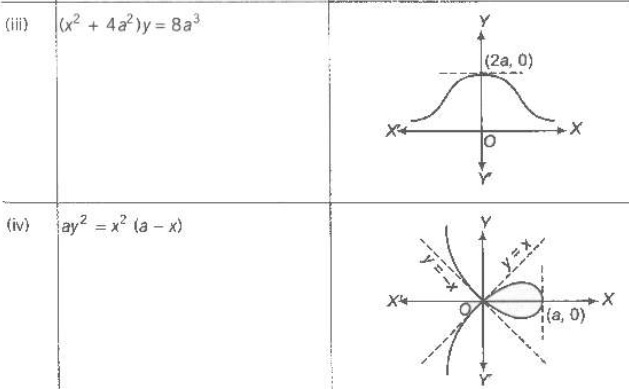

Copyright @ ncerthelp.com A free educational website for CBSE, ICSE and UP board.